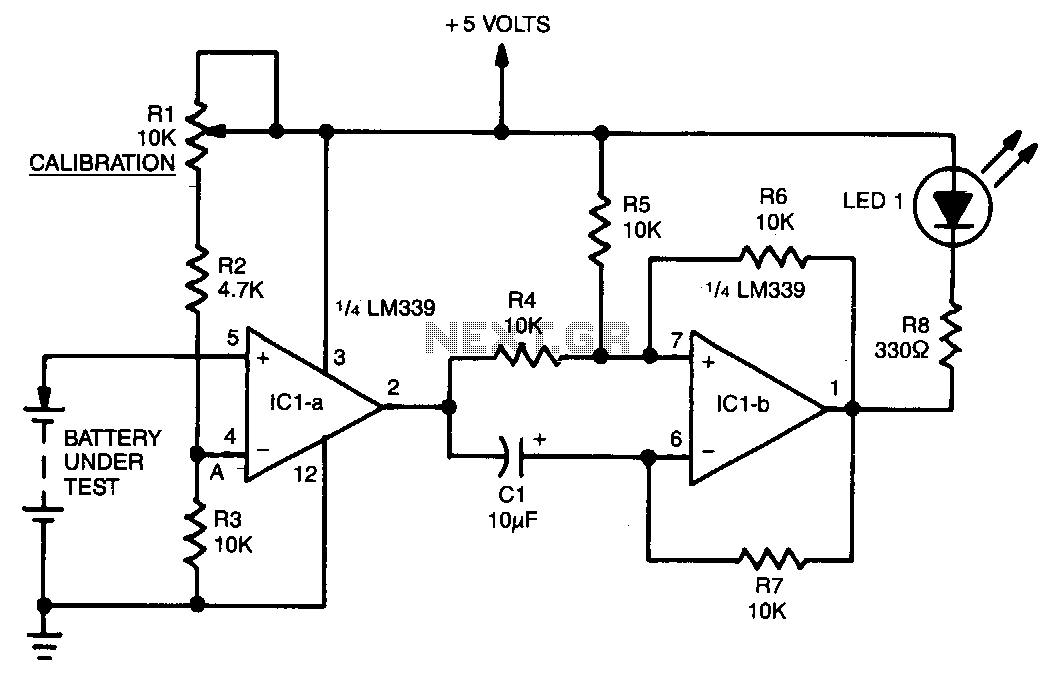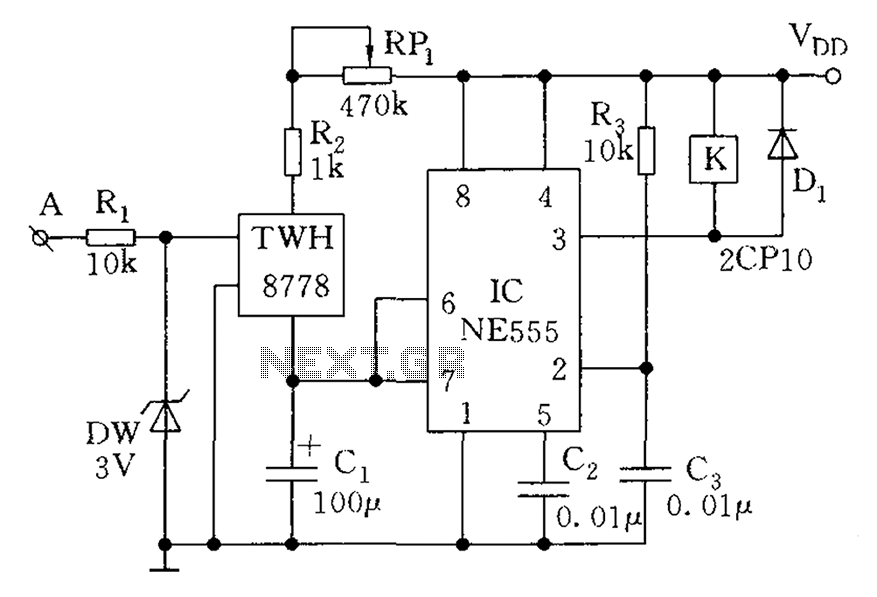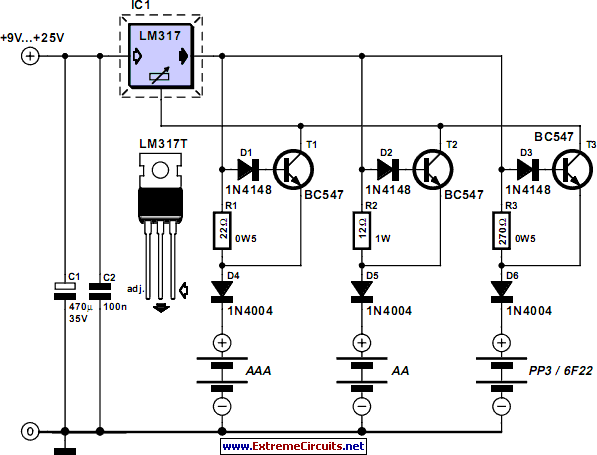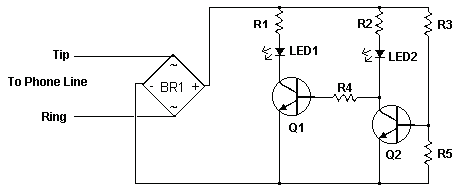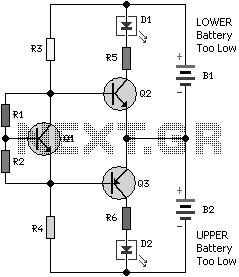
battery charging indicator for

While owning a modern NiCd battery charger, there may still be instances where an incompatible battery is encountered, such as one with a unique voltage requirement or one that necessitates a higher charging current than what a standard charger can provide. In these situations, many users opt for an adjustable mains adapter (for example, a 500-mA type) as a cost-effective solution to supply the necessary direct voltage for charging the battery. Although this method is neither fast nor particularly efficient, it functions under certain limitations. It is essential to have an understanding of the required charging current. If an adjustable but unregulated low-output current adapter is used, the current can be controlled by adjusting the output voltage. It is important to verify that the current is indeed flowing through the battery; therefore, a current-detecting indicator is preferable to a voltage indicator. To ensure visibility of the charging cycle, the indicator should be placed in a location that is frequently observed. The circuit described here activates an LED when the base-emitter potential of the transistor exceeds approximately 0.2 V. With a suggested resistor value of 1 ohm, this occurs at a current of around 200 mA, or about 40 mA if the resistor is changed to 4.7 ohms. The voltage drop from this indicator will not surpass the base-emitter voltage (UBE) of the transistor, which is roughly 0.7 V. Even if the current through the resistor increases beyond the point where UBE equals 0.7 V, the base of the transistor will accommodate the excess current. The recommended TO-220 style BU406 transistor is capable of handling base currents up to 4 A. This charging indicator effectively addresses the previously mentioned restrictions.
The circuit described utilizes a basic current detection mechanism to monitor the charging process of NiCd batteries. The adjustable mains adapter provides the required voltage, while the current indicator circuit ensures that the charging current can be monitored effectively. The LED indicator is an essential component, as it provides visual feedback regarding the charging status.
The circuit operates by employing a transistor (BU406) with its base connected to a resistor (R1) that is in series with the battery. When the current flowing through the resistor exceeds the threshold voltage of approximately 0.2 V, the transistor turns on, allowing current to flow through the LED, which subsequently illuminates. The choice of resistor value is crucial; a lower resistance value will result in a higher current threshold for the LED to light up, while a higher resistance will allow the LED to activate at a lower current, providing flexibility depending on the specific battery charging requirements.
The circuit is designed to maintain efficiency and safety. The transistor's ability to absorb excess current beyond the 0.7 V threshold ensures that it operates within safe limits, preventing damage to the circuit components. The TO-220 package of the BU406 transistor provides adequate heat dissipation capabilities, which is essential when handling higher currents.
Overall, this circuit serves as a practical solution for charging incompatible NiCd batteries, providing a simple yet effective method to monitor charging status while ensuring that the charging current remains within safe operational limits.Although you may well be the proud owner of the very latest NiCd battery charger, you may still come across the odd `incompatible` battery, for example, one having a rare voltage or requiring a much higher charging current than can be supplied by your off-the-shelf charger. In these cases, many of you will resort to an adjustable mains adaptor (sa y, a 500-mA type) because that is probably the cheapest way of providing the direct voltage required to charge the battery. Not fast and not very efficient, this `rustic` charging system works, although subject to the following restrictions: You should have some idea of the charging current.
In case you use an adaptor which is adjustable but of the unregulated, low output current type, you can adjust the current by adjusting the output voltage. You have to know if the current actually flows through the battery. A current-detecting indicator is therefore much to be preferred over a voltage indicator. To prevent you from forgetting all about the charging cycle, the indicator should be visible from wherever you pass by frequently.
Using the circuit shown here, the LED lights when the baseemitter potential of the transistor exceeds about 0. 2 V. Using a resistor of 1 as suggested this happens at a current of about 200 mA, or about 40 mA if R1 is changed to 4.
7. The voltage drop caused by this indicator can never exceed the base-emitter voltage (UBE) of the transistor, or about 0. 7V. Even if the current through R1 continues to increase beyond the level at which UBE = 0. 7 V, the base of the transistor will `absorb` the excess current. The TO-220 style BU406 transistor suggested here is capable of accepting base currents up to 4A. Using this charging indicator you have overcome the restrictions 2 and 3 mentioned above. 🔗 External reference
The circuit described utilizes a basic current detection mechanism to monitor the charging process of NiCd batteries. The adjustable mains adapter provides the required voltage, while the current indicator circuit ensures that the charging current can be monitored effectively. The LED indicator is an essential component, as it provides visual feedback regarding the charging status.
The circuit operates by employing a transistor (BU406) with its base connected to a resistor (R1) that is in series with the battery. When the current flowing through the resistor exceeds the threshold voltage of approximately 0.2 V, the transistor turns on, allowing current to flow through the LED, which subsequently illuminates. The choice of resistor value is crucial; a lower resistance value will result in a higher current threshold for the LED to light up, while a higher resistance will allow the LED to activate at a lower current, providing flexibility depending on the specific battery charging requirements.
The circuit is designed to maintain efficiency and safety. The transistor's ability to absorb excess current beyond the 0.7 V threshold ensures that it operates within safe limits, preventing damage to the circuit components. The TO-220 package of the BU406 transistor provides adequate heat dissipation capabilities, which is essential when handling higher currents.
Overall, this circuit serves as a practical solution for charging incompatible NiCd batteries, providing a simple yet effective method to monitor charging status while ensuring that the charging current remains within safe operational limits.Although you may well be the proud owner of the very latest NiCd battery charger, you may still come across the odd `incompatible` battery, for example, one having a rare voltage or requiring a much higher charging current than can be supplied by your off-the-shelf charger. In these cases, many of you will resort to an adjustable mains adaptor (sa y, a 500-mA type) because that is probably the cheapest way of providing the direct voltage required to charge the battery. Not fast and not very efficient, this `rustic` charging system works, although subject to the following restrictions: You should have some idea of the charging current.
In case you use an adaptor which is adjustable but of the unregulated, low output current type, you can adjust the current by adjusting the output voltage. You have to know if the current actually flows through the battery. A current-detecting indicator is therefore much to be preferred over a voltage indicator. To prevent you from forgetting all about the charging cycle, the indicator should be visible from wherever you pass by frequently.
Using the circuit shown here, the LED lights when the baseemitter potential of the transistor exceeds about 0. 2 V. Using a resistor of 1 as suggested this happens at a current of about 200 mA, or about 40 mA if R1 is changed to 4.
7. The voltage drop caused by this indicator can never exceed the base-emitter voltage (UBE) of the transistor, or about 0. 7V. Even if the current through R1 continues to increase beyond the level at which UBE = 0. 7 V, the base of the transistor will `absorb` the excess current. The TO-220 style BU406 transistor suggested here is capable of accepting base currents up to 4A. Using this charging indicator you have overcome the restrictions 2 and 3 mentioned above. 🔗 External reference
